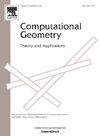在线课堂封面问题
IF 0.4
4区 计算机科学
Q4 MATHEMATICS
Computational Geometry-Theory and Applications
Pub Date : 2024-06-25
DOI:10.1016/j.comgeo.2024.102120
引用次数: 0
摘要
在本文中,我们研究的是在线类覆盖问题,在该问题中,几何对象的(有限或无限)族 F 和 Rd 中红色点的集合 Pr 都有一个先验值,而 Rd 中的蓝色点会一个接一个地到达。当一个蓝点到达时,在线算法必须做出一个不可逆的决定,用 F 中不覆盖 Pr 中任何点的对象来覆盖它。问题的目标是放置最少数量的物体。当 F 由 R2 中轴线平行的单位正方形组成时,我们证明了任何确定性在线算法的竞争比率都是Ω(log|Pr||),并为该问题提出了一种 O(log|Pr||)-竞争确定性算法。本文章由计算机程序翻译,如有差异,请以英文原文为准。
Online class cover problem
In this paper, we study the online class cover problem where a (finite or infinite) family of geometric objects and a set of red points in are given a prior, and blue points from arrives one after another. Upon the arrival of a blue point, the online algorithm must make an irreversible decision to cover it with objects from that do not cover any points of . The objective of the problem is to place a minimum number of objects. When consists of axis-parallel unit squares in , we prove that the competitive ratio of any deterministic online algorithm is , and also propose an -competitive deterministic algorithm for the problem.
求助全文
通过发布文献求助,成功后即可免费获取论文全文。
去求助
来源期刊
CiteScore
1.60
自引率
16.70%
发文量
43
审稿时长
>12 weeks
期刊介绍:
Computational Geometry is a forum for research in theoretical and applied aspects of computational geometry. The journal publishes fundamental research in all areas of the subject, as well as disseminating information on the applications, techniques, and use of computational geometry. Computational Geometry publishes articles on the design and analysis of geometric algorithms. All aspects of computational geometry are covered, including the numerical, graph theoretical and combinatorial aspects. Also welcomed are computational geometry solutions to fundamental problems arising in computer graphics, pattern recognition, robotics, image processing, CAD-CAM, VLSI design and geographical information systems.
Computational Geometry features a special section containing open problems and concise reports on implementations of computational geometry tools.

 求助内容:
求助内容: 应助结果提醒方式:
应助结果提醒方式:


